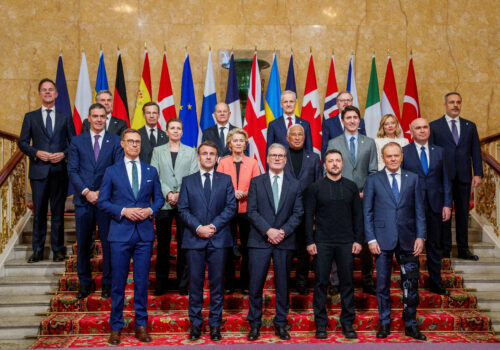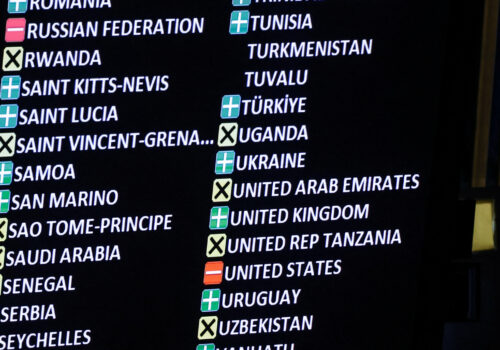As protests arise and First Amendment questions mount surrounding the immigration detention of Mahmoud Khalil, Rep. Rashida Tlaib, D-Mich. penned and circulated a letter demanding the immediate release of the recent Columbia University graduate.
It found little support among Tlaib’s colleagues in Washington, with a mere 14 Democrats signing their names on the letter condemning Khalil’s detention as an “illegal abduction.”
Instead, statements from prominent Democrats suggest much of the party is taking the Trump administration’s targeting of Khalil in good faith.
Rep. Adriano Espaillat, D-N.Y., who counts Khalil as one of his constituents, did not sign the letter. When contacted by The Intercept about the case, Espaillat said he expects the Trump administration – which has explicitly flouted and sought to circumscribe federal legal protections for civil liberties – to adhere to the rule of law.
“Regarding the case of Mahmoud Khalil, a constituent who lives in my district, my office has been following this case closely and as a former green card holder, I expect the Department of Justice to work within the confines of the law and that due process is guaranteed to him and his family,” Espaillat said in a statement Tuesday morning. “The rule of law must be respected.”
In a statement on Tuesday, Senate Minority Leader Chuck Schumer, D-N.Y., condemned Khalil’s activism and “antisemitic actions at Columbia,” without providing examples of those actions. He said that the administration should release Khalil if it could determine he had not broken any laws.
“This illegal justification has been stated clearly by figures throughout the administration, including the president himself.”
The Trump administration itself has admitted the case against Khalil does not hinge on allegations that he broke the law and told a conservative news outlet that it will these proceedings as a blueprint to target other students.
Tlaib’s letter — first reported by Jewish Insider — specifically calls out the Trump administration’s campaign for pushing to expel Khalil despite the fact he “has not been charged or convicted of any crime.”
“As the Trump administration proudly admits, he was targeted solely for his activism and organizing as a student leader and negotiator for the Gaza Solidarity Encampment on Columbia University campus, protesting the Israeli government’s brutal assault on the Palestinian people in Gaza and his university’s complicity in this oppression,” the letter said. “This illegal justification has been stated clearly by figures throughout the administration, including the president himself.”
In a bid to find additional backers, the letter was distributed among all 100 House members of the Congressional Progressive Caucus on Monday evening with a 10 a.m. deadline, according to a source familiar with the letter. Less than 15 percent of CPC members signed onto the letter, which was published Tuesday morning.
Signatories of the letter include: Andre Carson, D-Ind., Jasmine Crockett, D-Texas, Al Green, D-Texas, Summer Lee, D-Penn., Jim McGovern, D-Mass., Gwen Moore, D-Wisc., Ilhan Omar, D-Minn., Reps. Mark Pocan, D-Wisc., Ayanna Pressley, D-Mass., Delia Ramirez, D-Ill., Lateefah Simon, D-Calif., Rep. Rashida Tlaib, D-Mich., Nydia Velázquez, D-N.Y. and Nikema Williams, D-Ga.
At least one Democrat reportedly consulted about Khalil prior to his arrest. According to The Forward, an aide for Sen. John Fetterman, D-Penn., discussed Khalil’s situation with a former operative for the Zionist group Betar. The group has taken credit for sending a list of students it wanted deported to the White House. Betar named Khalil, misspelling his first name, in a tweet in January.
In response to a tweet on Monday from the Senate Judiciary Democrats calling to free Khalil, Fetterman replied: “Free all the hostages who have been tortured, starved, raped, beaten and STILL in tunnels in Gaza by Hamas since October 7th, 2023.” Fetterman’s office did not respond to a request for comment.
Correction: Tuesday, March 11, 11:09 p.m. ET
An earlier version of this article incorrectly identified the publication that first that reported an aide for Fetterman discussed Khalil prior to his detention. That was first reported by The Forward.
The post Dems for Some Reason Expect Trump to Follow the Law on Detention of Mahmoud Khalil appeared first on The Intercept.


 (@ScooterCasterNY)
(@ScooterCasterNY) 







